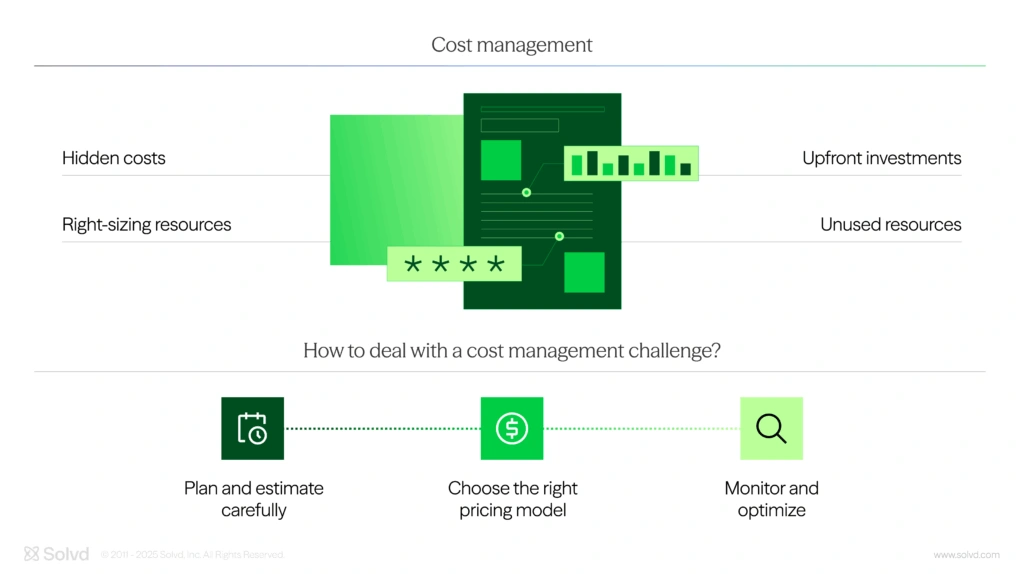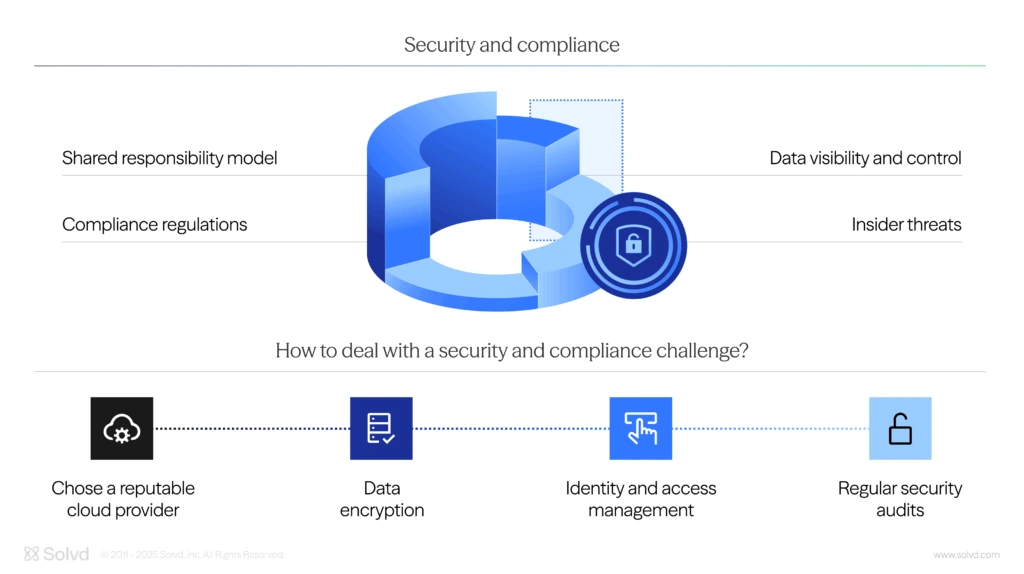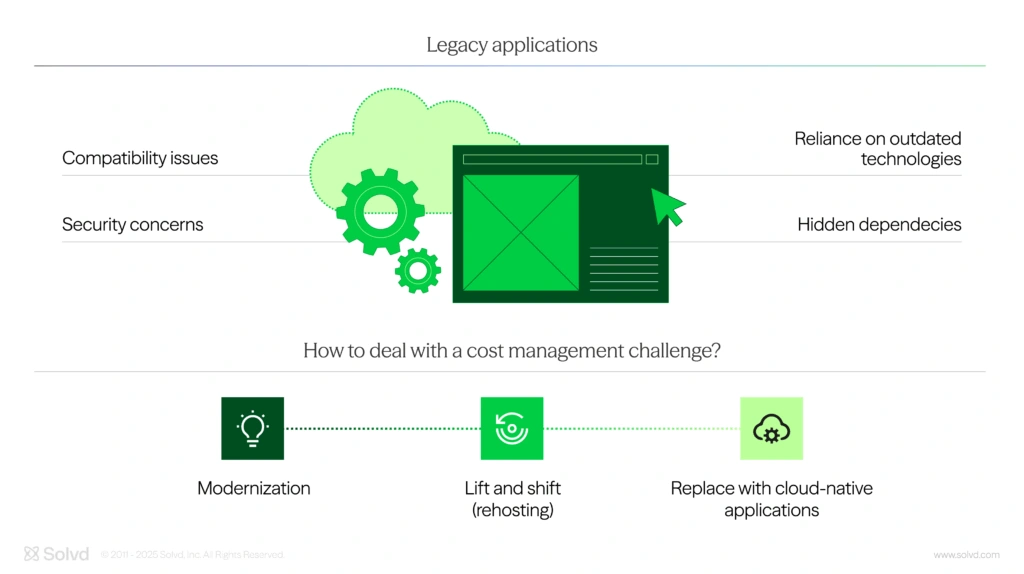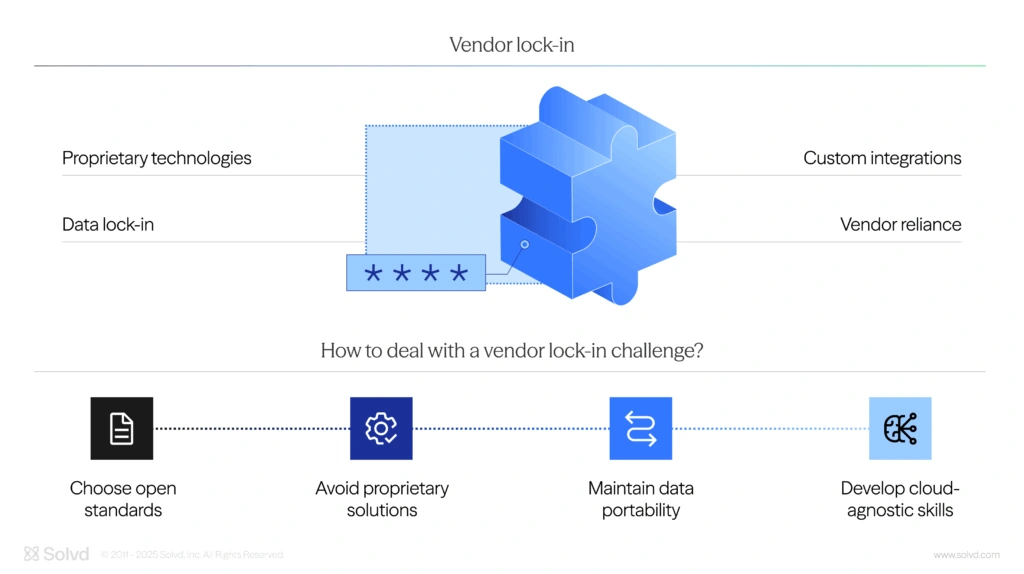Have you ever moved from one apartment to another only to discover that half of your furniture won’t fit through the new doorway? Cloud migration (the process of transferring IT resources to a cloud computing environment) can feel similarly chaotic. While the potential benefits – scalability, cost savings and improved agility – are undeniable, the journey itself is fraught with hidden hurdles. This article delves into the most common challenges encountered during cloud migration. We’ll offer practical strategies to navigate these roadblocks and ensure a smooth transition to the digital sky.
Five cloud migration challenges and their solutions
Many companies are blinded by the benefits that cloud migration has to offer and they often underestimate how complex this process can be. However, it is necessary to take into account the two sides of the coin when making such an important decision and to consider the following cloud migration challenges as well.
Cost management

Despite the potential cost savings brought by cloud computing, this process can be a surprisingly expensive undertaking. A study by Flexera found that 70% of businesses exceed their cloud budgets and it highlighted cost management as a significant challenge during cloud migration. This can be attributed to the following factors.
- Hidden costs. Cloud services are often priced on a pay-as-you-go model, which sounds great in theory. But there can be hidden costs that add up quickly. Think of it like a move to a new apartment – the rent might be lower, but you now have to factor in the internet, utilities, and maybe even having to pay for parking. In the cloud, there might be data transfer fees, egress fees (moving data out of the cloud), and storage costs that can surprise you if you haven’t planned carefully.
- Upfront investment. Migrating to the cloud isn’t just about flipping a switch. There can be upfront costs associated with the process itself. This could include fees for data migration services, software licenses for cloud-based tools, or even consulting fees for experts to help guide the migration. Imagine packing and unpacking for your move, you might need boxes, a moving truck or help from friends, all of which add to the initial cost.
- Right-sizing resources. One of the benefits of the cloud is that you can scale your resources up or down on an as needed basis. But if you don’t size your cloud resources correctly from the start, you could be paying for more than you need. It’s akin to renting a giant mansion when a cozy studio would do just fine. For example, if you provision a virtual machine with too much processing power for your workload, you’ll be wasting money. Conversely, if you provision too little, you could experience slow performance.
- Unused resources. Even with proper initial sizing, cloud environments are dynamic. Let’s say you have a website that sees a surge in traffic during the holidays. If you don’t have proper monitoring in place, you might be continuing to pay for the extra resources you need during the peak period, even when traffic goes back down. This is like leaving all the lights on in your new apartment even when you’re not home.
So, how can you tackle this cost management cloud migration challenge? Here are a few tips:
- Plan and estimate carefully. Before migrating, thoroughly assess your current IT infrastructure and resource usage. This will help you estimate your cloud needs and avoid overprovisioning.
- Choose the right pricing model. Cloud providers offer various pricing models. Explore options like reserved instances (committing to a set amount of resources for a discounted price) or spot instances (using unused resources at a lower cost) to optimize your spending.
- Monitor and optimize. Once you’ve migrated, continuously monitor your cloud resource usage. Look for opportunities to right-size your resources and leverage features like auto-scaling to adjust resources automatically based on demand.
Security and compliance

Security and compliance remain one of the leading cloud migration challenges for organizations all over the world. A staggering 56% of CIOs report facing problems related to security and compliance risks during the migration process. This concern stems from the following factors:
- Shared responsibility model. In the cloud, security is a shared responsibility. The cloud provider secures the underlying infrastructure, but you’re responsible for securing your data and applications within that environment. It’s like living in an apartment building – the landlord maintains the building itself, but you’re responsible for locking your own door and keeping your valuables safe.
- Data visibility and control. When your data is on-premises, you have complete physical control over it. In the cloud, your data is now on someone else’s servers. This can raise concerns about data visibility and control. Think about storing your valuables in a safe deposit box at the bank. While the bank has security measures in place, you might not have the same level of immediate access and control like you would at home.
- Compliance regulations. Many industries have strict data privacy regulations like HIPAA in healthcare or GDPR in Europe. You need to ensure that your chosen cloud provider meets these compliance standards and that your migration process adheres to them as well. It’s like having to follow all of the building codes during a home renovation. Migrating to the cloud can’t come at the expense of violating any of the required data privacy regulations.
- Insider threats. Even with robust security measures, insider threats can still pose a risk. This could be a disgruntled employee or someone who gains unauthorized access to your cloud environment. This is similar to the risk of someone having a spare key to your apartment building. Even if the building itself is secure, there’s still the possibility of someone you know who might let unauthorized people in.
So, how can you navigate this security and compliance challenge? Here are some steps to take:
- Choose a reputable cloud provider. Select a cloud provider that has a proven track record of security and compliance. Look for certifications like SOC 2 or ISO 27001, which demonstrate their commitment to data security. Researching the provider’s security practices is like checking the crime rates and security measures in your new neighborhood before you move in.
- Data encryption. Encrypt your data both at rest (stored in the cloud) and in transit (moving to and from the cloud). Encryption scrambles your data, which makes it readable only to those who have the decryption key. This is like putting your valuables in a locked box before you store them in the safe deposit box.
- Identity and access management (IAM). Implement strong IAM controls to restrict access to your cloud resources. This includes using multi-factor authentication (MFA) and the principle of least privilege, which grants users only the access they need to perform their jobs. Think about it like having a unique key for your apartment rather than sharing it with everyone in the building.
- Regular security audits. Don’t just set it and forget it. Regularly conduct security audits of your cloud environment to identify and address any potential vulnerabilities. This is like having your apartment locks checked periodically to ensure that they’re still secure.
Legacy applications

Moving your business to the cloud promises a land of agility and innovation. But what about those trusty, old-fashioned applications that have been running your operations for years? These legacy applications (which were built for a bygone era of on-premises servers) can be a major hurdle in the cloud migration journey. Imagine packing for a move and encountering a dusty box that’s filled with an antique record player and a stack of VHS tapes. These items might have been valuable once, but they don’t quite fit into your new, modern life.
Here’s why legacy applications can be considered among major cloud migration challenges:
- Compatibility issues. Legacy applications were designed for specific hardware and software environments. Migrating them directly to the cloud might reveal compatibility issues and cause them to malfunction or perform poorly. It’s like trying to play your old VHS tapes on a brand-new smart TV – the formats just don’t match up.
- Reliance on outdated technologies. Older applications might rely on outdated programming languages or technologies that aren’t well-suited for the cloud. This can make them difficult to maintain and update in the cloud environment. Think about trying to use a rotary phone in today’s world of touchscreens and voice assistants – the technology is simply outdated.
- Security concerns. Legacy applications might have inherent security vulnerabilities that weren’t a major concern in the more controlled environment of on-premises servers. These vulnerabilities could be exposed in the cloud and put your data at risk. Imagine leaving your house unlocked back in the day when everyone knew their neighbors – it might have been okay back then, but not so much these days.
- Hidden dependencies. Legacy applications often have complex dependencies on other outdated systems. These dependencies might not be readily apparent, which makes it difficult to isolate and migrate the application without causing disruptions elsewhere. It’s like that box of tangled Christmas lights – you untangle one string only to discover that it’s connected to another mess of wires!
So, how can you navigate this legacy application challenge? Here are some approaches to consider:
- Modernization. In some cases, it might be beneficial to modernize your legacy applications before migrating them to the cloud. This could involve rewriting code, updating libraries, or containerizing the application for easier cloud deployment. Think about giving your old record player a Bluetooth adapter so you can still enjoy your favorite vinyl but in a modern way.
- Lift and shift (rehosting). For less critical applications, a simpler approach might be to “lift and shift” them to the cloud as-is. This involves migrating the application to a virtual machine in the cloud environment. While it’s not ideal for long-term use, it can be a quick and easy way to get some applications up and running in the cloud. Imagine putting your old record player in the corner of your new living room – it’s not the most elegant solution, but it works for now.
- Replace with cloud-native applications. It might be best to replace some legacy applications with cloud-native applications that are explicitly designed for the cloud environment. Doing this can offer better performance, scalability, and security. Think about replacing your old VHS tapes with streaming services – it’s like a whole new way to enjoy your favorite movies and shows.
Vendor lock-in

The cloud promises a land of flexibility and freedom that allows you to scale resources up or down as needed. But there’s a potential pitfall to watch out for – vendor lock-in. Imagine moving to a new apartment building and discovering that all of the doors and appliances only work with special keys and adapters that are specific to that building. In the cloud, vendor lock-in can make it difficult and expensive to switch over to a different cloud provider later.
Here’s how vendor lock-in can become one of the key cloud migration challenges:
- Proprietary technologies. Some cloud providers offer unique features and functionalities that aren’t readily available elsewhere. These proprietary technologies can become deeply ingrained in your applications, which makes it difficult to migrate them to another platform without significant re-work. Think about those special keys and adapters in your apartment – they’re great if you stay, but not so much if you decide to move.
- Custom integrations. As you integrate your cloud services with other applications and tools, you might develop custom solutions that are specific to your chosen cloud provider’s platform. These integrations can become a barrier to switching providers, because they may not be easily replicated elsewhere. Imagine having built-in shelves that perfectly fit your apartment – they’re helpful, but not if you move to a place that has different wall layouts.
- Data lock-in. Migrating large amounts of data between cloud providers can be a complex and time-consuming process. Some providers might offer limited data portability options, which makes it difficult to move your data out if you decide to switch. This is like having all your furniture custom-built to fit your old apartment – it might be great there, but it won’t work in a new place that has different dimensions.
- Vendor reliance. Over time, your IT team might develop a strong comfort level and expertise with a specific cloud provider’s tools and services. This can lead to a dependence on that vendor. This can make it psychologically challenging to consider switching providers, even if it might be beneficial from a cost or functionality perspective.
So, how can you avoid the vendor lock-in trap and ensure long-term flexibility in the cloud? Here are some steps to take:
- Choose open standards. When selecting a cloud provider, prioritize platforms that support open standards and APIs. This allows for easier data portability and integration with other tools, regardless of the vendor. Think about choosing furniture that’s standard size and not built-in – it might offer less initial customization but it gives you more flexibility in the long run.
- Avoid proprietary solutions. While proprietary features might be tempting, be wary of becoming overly reliant on them. Instead, focus on cloud-agnostic solutions that can be easily migrated between providers if needed. Imagine using modular furniture that can be rearranged into different layouts – it gives you flexibility and it adapts to your needs.
- Maintain data portability. Develop a data management strategy that ensures your data can be easily exported from your chosen cloud platform. This might involve using tools that support common data formats or backing up your data regularly to an independent storage solution. Think about keeping your important documents and possessions stored in a separate storage locker – you can still access them easily if you move to another apartment.
- Develop cloud-agnostic skills. Invest in training your IT team on cloud-agnostic skills and best practices. This will reduce their reliance on a specific vendor’s tools and it will make them more adaptable to different cloud environments. Imagine learning general carpentry skills instead of focusing on how to use a specific brand of toolbox – it gives you a wider range of options and problem-solving abilities.
Downtime and disruption

Around 40% of businesses experience downtime or service disruptions during a migration. This downtime can create a lot of negative consequences for the business. Imagine planning a big launch party for your new product, but you experience a power outage right before the big event. Downtime during a cloud migration can have a similar disruptive effect on your business operations.
Here’s why downtime and disruption can be one of the most important cloud migration challenges:
- Application outage. The migration process itself can lead to application outages. This is because data and applications might need to be transferred from your on-premises environment over to the cloud and it can cause temporary interruptions in service. Think about packing boxes and moving furniture – it’s hard to use a room while it’s in complete disarray.
- Integration issues. Migrating to the cloud often involves integrating your existing systems with new cloud-based services. These integrations can be complex and it can lead to unexpected glitches and/or compatibility issues, causing further downtime. Imagine moving your appliances to your new apartment, only to find out they don’t fit the electrical outlets and they require special adapters to function properly.
- Testing and validation. Thorough testing and validation are essential to ensure a smooth cloud migration. However, this testing itself can lead to temporary disruptions as you identify potential issues and troubleshoot them. Think about having a fire drill in your office building – it might disrupt your workflow for a short while, but it’s a worthwhile step for ensuring everyone’s safety in the long run.
- User impact. Any downtime during the migration can impact your users, whether it’s employees relying on internal applications or customers accessing your website. This can lead to both frustration and lost productivity. Imagine the disappointment of your guests arriving for your product launch party only to find the doors locked!
So, how can you minimize downtime and disruption during your cloud migration? Here are some strategies to consider:
- Phased migration approach. Instead of a big bang migration where everything gets moved all at once, consider taking a phased approach. This allows you to migrate applications or systems in smaller groups, which minimizes the overall impact on users. Think about packing and moving only one room at a time instead of trying to do everything all at once on the same day.
- Careful scheduling. Schedule your migration during off-peak hours or during periods that see minimal business activity. This will help reduce the impact of any downtime on your users. Imagine planning your move over a weekend when the office is closed in order to minimize disruption to your employees.
- Disaster recovery plan. Have a robust disaster recovery plan in place to address any unforeseen issues that might arise during the migration. This includes having backup systems and procedures to restore functionality quickly. Think about having a backup generator for your product launch party in case there’s a power outage – it ensures the event can still go on, even if there is a minor hiccup.
- Communication is key. Keep your employees and customers informed throughout the migration process. Provide clear communication about potential downtime, expected timelines, and any necessary changes in workflow. Imagine sending your product launch party invitations out well in advance, including a mention of possible delays because of the move.
Conclusion
While cloud migration challenges can present hurdles, having a comprehensive plan, a skilled migration team, and a proactive approach can effectively mitigate them. By carefully assessing security concerns, optimizing workloads for the cloud and establishing a robust cost management strategy, organizations can navigate cloud migration challenges and unlock the full potential of cloud computing. The journey to the cloud may not be without its bumps, but by anticipating these cloud migration challenges and implementing effective solutions, businesses can ensure a successful cloud migration and reap the long-term rewards of having a more agile, scalable and cost-effective IT infrastructure.









